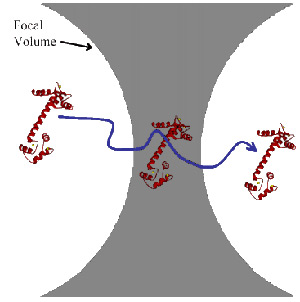The Johnson Research Group
Burst Fluorescence Measurements
As a single CaM-DA molecule passes through the focal volume of about 5 femtoliters, occurrences of high counts are obtained in donor and acceptor channels as seen in the figure below.


The donor and acceptor counts can be used to calculate a FRET-efficiency (E), where c is a correction factor to account for differences in detection efficiency of the two channels and b is an average bleedthrough of donor fluorescence into the acceptor channel.

From the FRET-efficiency a distance (R) can be calculated. The term R0 is called the Förster distance and corresponds to the distance of 50% energy transfer from donor to acceptor, for the FRET pair AF-488 and TexasRed the R0 is 46.5 Å

From the burst data a histogram of distances between residues 34 and 110 can be compiled from the high signal bins.
Multiple conformations have been observed, which is direct evidence that CaM is sampling multiple substates in solution. The conformations may be similar to different crystal structures of Ca2+-CaM.
Using this FRET construct, we are also able to monitor microsecond time scale distance fluctuations between lobes of CaM, and observe the effect of Ca2+, pH, and oxidative modification on these motions.
Publications
Slaughter, B. D., Allen, M. W., Unruh, J. R., Urbauer, R. J. B., Johnson, C. K. 2004. Single-molecule resonance energy transfer and fluorescence correlation spectroscopy of calmodulin in solution. Journal of Physical Chemistry B. 108:10388-10397.